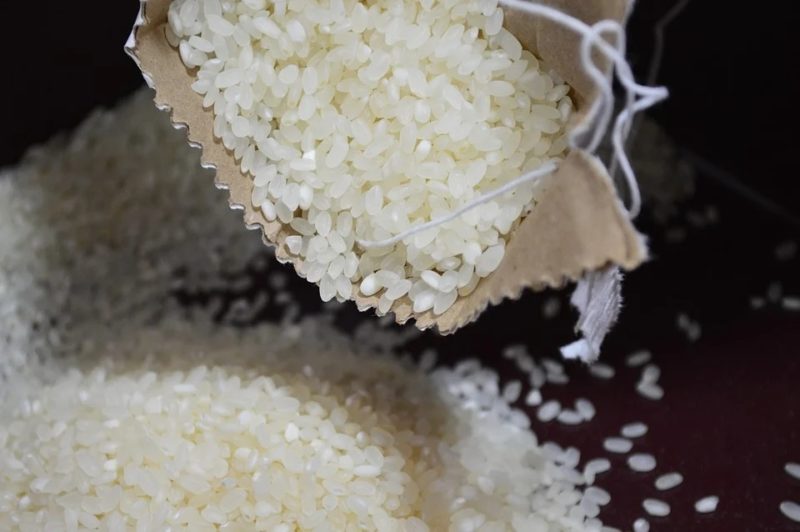If you want to learn how to make a weighted blanket with rice, you will be finished in just three steps! This guide will also mention the best technique to know how much rice you need for the blanket. Do you have other weighted blanket FAQS?
We will also teach you some valuable tips for choosing weighted blanket materials, ideal weighted blanket size and weight, and more. We have even written a step-by-step guide on making a weighted blanket with removable weights.

Step By Step Guide On DIY Weighted Rice Blanket
Step 1. Prepare your fabric pieces and sew the quilt
Prepare four fabric pieces according to the size of the weighted blanket you want to make. For example, two and a half yards for each piece is enough to make a twin-size blanket. Once you have the materials, place two fabric pieces on top of each other with their right sides together and pin to make the quilt.
Sew along the three edges and turn the inner blanket layer you made using the open or top side. Create a grid of squares according to the finished blanket dimension. For example, you will need 6 columns and 15 rows of 6 by 6-inch squares to make a blanket measuring 66 by 90 inches.
Step #2. Determine the amount of rice for the weighted blanket
The amount of rice you’ll use to fill the blanket is the number when you divide the total rice requirement by the total number of squares you need for the blanket size. Then, sew the columns according to the square size and fill each column with the rice you computed.
Step 3. Place the blanket cover and finish
Make the first row by sewing horizontally along the width of the blanket and pour rice into each column again. Continue with the process to reach the blanket top. Then, work on the blanket cover using the two remaining fabric pieces.
Pin the fabric pieces over each other and sew on all sides except the bottom edge. This opening will be closed after you placed the quilted rice blanket inside. You can use any closure style you want, but ribbons would be the most straightforward.
What Do You Fill A Weighted Blanket With?
The most common fill for a weighted blanket is plastic polypropylene pellets. They are safe for washing, and you can even use the washing machine, which makes weighted blanket maintenance much quicker and efficient. However, you can also use glass or steel beads for a washable weighted blanket but with a longer lifespan.
Can you make weighted blankets with rice?
What about organic materials? Beans, grains, and rice are also famous for DIY weighted blankets because of the low cost. However, you will need more materials to achieve a good weight, and these organic fillers are not compatible to get wet, or else you’ll ruin the blanket and develop insects and mildew.
What is the best fabric for weighted blankets?
Some excellent fabric types for weighted blankets include cotton, bamboo, or even fleece. Is it cheaper to make your weighted blanket, and you have many advantages because you can select the materials. But regardless of whatever filler you use, you also have to choose the best quality fabric for the weighted blanket.
It should be durable enough to hold the fillers, but still soft and breathable for comfort. More so, you have to consider how easy it is to maintain the fabric, especially the outer blanket cover. Some people are sensitive to other materials, and some fabrics may feel uncomfortable in hot weather.
How To Make Weighted Blankets For Babies
If you are thinking of making and using a baby weighted blanket, it’s crucial to remember that children under the age of two must never use a weighted blanket. Very young children shouldn’t even use baby blankets such as receiving and swaddling blankets without supervision. While weighted blankets can help with insomnia and offer soothing comfort for sleep, the pressure is incompatible with a baby’s developing body.
More so, babies are at high risk for suffocation, and their sleeping surfaces should be free of any items. Remember that the sensory-based solution that weighted blankets offer will work differently for every person. According to the Nationwide Children’s Hospital, please check in with your child’s care provider and do not test weighted blankets on children without consultation.
How Heavy To Make A Weighted Blanket?
Can a weighted blanket be too heavy? A weighted blanket’s weight should be 10% of the weight of the user. You can also add one to two pounds to this number since comfort is subjective.
If the user finds the blanket’s compression lacking, you can increase its weight a bit.
How big to make a weighted blanket?
The individual’s height and bed determine the size of the weighted blanket. It should cover the person’s chin to heel so that the blanket won’t hang off the sides of the bed and get challenging to adjust. You can also choose the size ideal for targeting the body’s pressure points without applying load on the face.
Conclusion
Did you know that pellets are not the only fillers you can use for a DIY weighted blanket? A quick recap on this guide for how to make a weighted blanket with rice, you will only need to make a quilt, fill it with rice, and place it inside the blanket cover. Please remember our tips for the weight and sizing of weighted blankets and never use one for a child under a year old.
